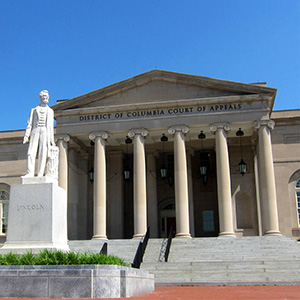Civil Rights Lawyers Discuss Racial Equity in Criminal Law
April 13, 2021
On April 12 the D.C. Bar Public Interest and Courts Community, in partnership with the Washington Lawyers’ Committee for Civil Rights and Urban Affairs, presented the program “Racial Equity in the Criminal Law Context,” which focused on policing and social justice issues.
Moderated by DC Justice Lab Executive Director Patrice Sulton, the discussion featured Roy Austin, Facebook’s vice president of civil rights and deputy general counsel, and Jonathan M. Smith, executive director of the Washington Lawyers’ Committee, who shared their critiques of the legal status quo and its impact on disadvantaged people of color.
Austin said he views policing and incarceration rates as a kind of self-fulfilling prophecy in which communities of color are policed heavily and punished severely for minor infractions, resulting in financial and social difficulties that foreclose opportunities for advancement. Reforming the criminal justice system could address many of the problems that policing claims to mitigate but merely aggravates, Austin said.
“Locking up people for an extended period of time does not work. It does not bring down the crime rate. It does not work generationally,” Austin said. “We need to find ways to help people get out of the system, to help people find constructive and productive ways to contribute to society.”
An April 2021 report by the District of Columbia Police Reform Commission supports this argument, stating that “[h]istorically and presently, the institution of policing has served as a tool of systemic racism and has done considerable damage to Black and Brown communities with impunity.”
Smith, who has worked on prisoners’ rights issues for decades, said policies related to policing and criminal law were developed by individuals who later explicitly acknowledged their prejudicial intent. For example, in a 1994 interview, Nixon’s domestic policy adviser John Ehrlichman acknowledged that the war on drugs targeted Black people.
“The Nixon campaign in 1968, and the Nixon White House after that, had two enemies: the antiwar left and black people. . . . We knew we couldn’t make it illegal to be either against the war or black, but by getting the public to associate the hippies with marijuana and blacks with heroin, and then criminalizing both heavily, we could disrupt those communities,” Ehrlichman said in an interview with journalist Dan Baum.
In this context, the panelists said, change cannot occur simply by identifying and removing individual bad actors. Smith told the story of a woman who, on two occasions, received citations for allowing parking meters to run out. This resulted in less than $250 in fines, but a missed payment on the repayment program caused the figure to balloon to more than $1,600. She spent time in jail, she lost her job, and her children were placed in foster care. Smith said that this trajectory was due to structural inequities, adding that individual prosecutions fail to address the problems that result in negative outcomes for people of color.
“You can’t untangle the inequity in education, housing, employment, and law enforcement. They all work together to sustain the social control over Black communities and the maintenance of the supremacy of the white community,” said Smith.
Austin believes there are better solutions available to society to ensure order and security than the expansion of the criminal justice system. “The criminal justice system cannot solve these problems,” he said. “The system is a small [way] of ensuring some level of accountability, but we over-sentence without a basis. We sentence people and prosecute people and arrest people based on bias far too often. That is not where the work needs to be done. If we truly believe that people who are given an opportunity and given a chance are going to succeed, then let’s give them an opportunity and a chance.”





